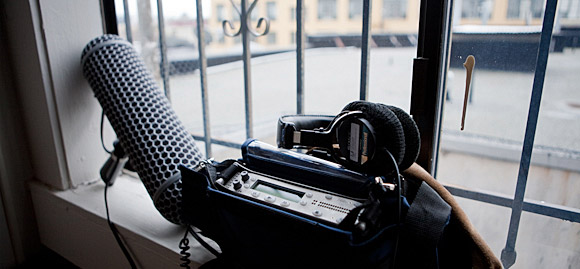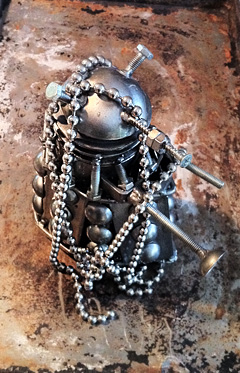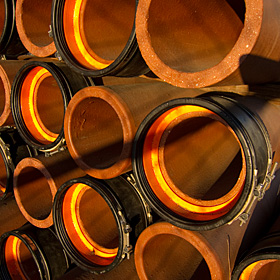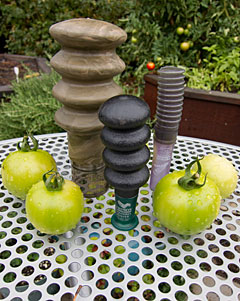Posted: May 4th, 2011 | Author: Nathan | Filed under: field recording, found sound objects, sound design

"Ol' Wheezy" the Water Spigot, as we called him, at our campground in the desert.
[One in a series of posts from my spring 2011 trip to the southern California desert.]
Joshua Tree National Park is in the Mojave Desert. It’s dry. Only two campgrounds in the entire park have running water of any kind. Bad weather on the coast of California caused us to decide to stay in the desert at the tail end of a week’s vacation, so we were lucky to just show up at Joshua Tree and grab a spot at one of these prime campgrounds.
I camp a lot, all over the place, but I had never seen a water spigot quite like the one near our site. It was like the wet dream of a post-apocalytpic film production designer: Big, industrial, heavy, and red. If a common water pump could be bad ass, this one could.
Anyway, the draw-up of water sounded really neat, so I whipped out the ol’ handheld recorder and took some samples on our last morning there. It reminded me a bit of the sound of EVE coming out of her landing ship’s tube from the film WALL•E.
In developed campgrounds, you need to be up really early to avoid noise from fellow campers. No wonder I like backpacking so much…
[soundcloud url=”http://api.soundcloud.com/tracks/13996448″ params=”show_comments=true&auto_play=false&color=ee0000″ width=”100%” height=”81″ ]
[Sony PCM-D50 recorder, capsules at 120°]
Tags: desert, digital audio, field recording, industrial, joshua tree, machine, sound design, sound effects, travel, whoosh | 6 Comments »
Posted: April 21st, 2011 | Author: Nathan | Filed under: field recording, found sound objects, sound design

While this isn't the rig used for today's recording, this window's cruddy construction and age yielded some interesting sounds!
At work one day, I noticed that a large truck on the street was causing one of our single-pan glass windows to rattle. I whipped out my Sony PCM-D50 and captured some of it – that’s today’s sound you can hear below.
The audio quality of this clip isn’t great (lots of bleed from outside noises, but hey, it’s a cruddy old window – and that’s why it was rattling like that!), but it brought to mind an interesting idea: Windows rattling in their casements are pretty strange sounding, and it is a sound I’ve not heard used in films (or if it has been, it’s rare and I don’t recall consciously hearing it before). It struck me as an interesting idea for future sound design in buildings under stress, or just for creepy interiors. I did a lot of shaking of the window manually, but nothing quite captured the high-speed rattle of this original recording, so I hung onto it for a reference.
It’s a craptastic recording, though. But it just goes to show you that sometimes pressing the “Record” button might not give you the cleanest sound, but can still capture a reference sound that you can try to emulate, re-use in different ways, or to suggest whole new concepts that you might not have considered before. In this case, it made me realize what parts of buildings might have deteriorated when they get to be a certain age, which can help to inform the design of such ambiences or effects in the future.
[soundcloud url=”http://api.soundcloud.com/tracks/8225428″ params=”show_comments=true&auto_play=false&color=ee0000″ width=”100%” height=”81″ ]
[Sony PCM-D50 recorder, 90° capsule spread]
| 4 Comments »
Posted: January 20th, 2011 | Author: Nathan | Filed under: found sound objects, sound design

Mr. Heater, the oddest and loudest camping stove ever.
One of the guys at work loves camping gadgets (as do I), and he shared a video of his odd little Mr. Heater camp stove making some weird unholy racket. Naturally, I asked to borrow it and did some recording sessions with it over the holidays.
A metal reflector lets the unit be used as either a heater or a camp stove. This ring of steel doesn’t make much sound when it’s running (all you hear is the hiss of gas emission, much like this recording), but it sure resonates when the stove fires up, starting as one tone and diverging into two separate tones, creating a harmony. Very effective or driving away bears, or as a means for summoning the dead.
The only processing applied to this sound is some noise reduction to minimize the gas regulator’s hiss, to pull the resonance forward. Recorded at 192kHz, a clip like this is ripe for pitch shifting for even scarier tones! (Mic placement was tricky; placing the mics right in front would melt them instantly.)
[soundcloud url=”http://api.soundcloud.com/tracks/9154382″ params=”show_comments=true&auto_play=false&color=ee0000″ width=”100%” height=”81″ ]
[Sennheiser MKH 50/30 pair, rigged for mid-side stereo, into a Sound Devices 702 recorder]
Tags: field recording, industrial, metal, resonance, sci-fi, sound design, sound effects | 5 Comments »
Posted: December 20th, 2010 | Author: Nathan | Filed under: found sound objects, sound design

Exterminate! Exterminate!
In North America, the end of the Western calendar year brings Thanksgiving, Hanukkah, Kwanza, Christmas…lots of holidays, most of which revolve around eating. In our household, that means one thing above all else: PIE SEASON.
My wife loves making pies and tarts, and one of the baker’s secret weapons for such endeavors are pie weights. They’re simply large, heavy versions of the more common metal-ball-style keychain. Ours is about four feet in length.
While washing dishes after a piemaking bonanza, I noticed the sound it made as I dragged it over the lip of our stainless steel sink. Finally, on a rainy winter day, I decided to do some recording and processing.
I grabbed three things for this session: The pie weights, a really beat-up baking sheet, and a small model of a Dalek made from spare parts (a gift from a dear friend). I simply moved the pie weights across each of these objects in different ways. Hot metal-on-metal action!
The balls on the pie weights made a great ratcheting sound that instantly made me think of a castle portcullis being raised and lowered, or a ship’s winch retracting an anchor. Of course, the size of these weights made pretty bright sounds, but that’s what pitch shifting is for…
So, today’s sound is a mix of these sounds, some raw, and some pitched down significantly. I didn’t do anything besides pitch shifting and EQ, just to show how flexible these high-frequency, detailed sounds can be when recorded at 192kHz. These sounds were recorded with a large-diaphragm condenser mic, because I found that proximity effect from close-miking with a small-diaphragm condenser produced too much bass to provide the balanced, bright sounds that I was going after.
[soundcloud url=”http://api.soundcloud.com/tracks/8225412″ params=”show_comments=true&auto_play=false&color=ff7700″ width=”100%” height=”81″ ]
[Røde NT1a microphone into Sound Devices 702 recorder]
Tags: dalek, digital audio, field recording, industrial, machine, metal, pie, sound design, sound effects | 5 Comments »
Posted: November 16th, 2010 | Author: Nathan | Filed under: field recording, found sound objects

Home of the ceiling fan in question, and the weirdness that followed.
When in Mexico two years ago, the villa in which I stayed had a ceiling fan with very different voices when set to low and high. I’ve included a short sample of this fan at low, sounding like a grinding motor, and high, when the motor when silent but the blades sounded like a small helicopter.
Weirder than this sound was the villa, which was huge and beautiful, and overlooked the beach and the Pacific Ocean. It was surrounded by a river choked with human filth. Then the Dallas Cowboy Cheerleaders showed up. Then I thought I would die from food poisoning. All in one day.
True story. Tell you more over a beer sometime. Sorry, no cheerleader sounds were recorded.
[soundcloud url=”http://api.soundcloud.com/tracks/7100811″ params=”show_comments=true&auto_play=false&color=ee0000″ width=”100%” height=”81″ ]
[Zoom H2 recorder]
Tags: digital audio, field recording, found object, Mexico, sound design, sound effects, travel | 4 Comments »
Posted: October 30th, 2010 | Author: Nathan | Filed under: field recording, found sound objects, sound design

Pipes along the side of the road. This is the kind of "a-ha!" or "ooh!" moment recordists wait for!
[Just had to post something orange and slightly eerie. Happy Halloween, all!]
It was a quiet night in a San Francisco warehouse district: Calm wind, not a lot of people on the streets, the sun was going down. A bunch of pipes – probably for redoing water lines beneath the street – were stacked on the sidewalk, perpendicular to the street.
This is precisely the reason that I carry a small, handheld field recorder with me at all times. I shoved it into a few pipes to check out what I could hear. I got some really nice drones with that added pipe/tube resonance and comb filtering, which will definitely go in my growing and rather extensive “unsettling drone” library. Some of the car passbys in the street had a resonant, screaming quality, which may make good spaceship pass-bys as well, or aggressive layers for expressive car ‘bys.
But, I quite liked some of the passages where this drone mixed with the activity of the street. Today’s sound is recorded within a 12″ diameter concrete pipe about six feet long. A lone man walks down the street singing, followed by a bicycle, he continues singing then crosses the street in front of me, a breath of wind really amps up the resonance for a moment, and then a few cars pass by, kicking up loose asphalt. Although it sounds like a mix of street noise with a synth drone underneath it, this is unedited except for some compression and normalization. The imaging is incredibly tight because there was about six feet of 12″ pipe in front of the mic capsules, narrowing the stereo field.
[soundcloud url=”http://api.soundcloud.com/tracks/6555355″ params=”show_comments=true&auto_play=false&color=ee0000″ width=”100%” height=”81″ ]
[Sony PCM-D50 recorder, 90° capsule spread]
Tags: audio equipment, comb filtering, digital audio, field recording, pipe, resonance, singing, sound design, sound effects, tube, urban | 3 Comments »
Posted: October 28th, 2010 | Author: Nathan | Filed under: field recording, found sound objects

Beer, toiletries, ice chest, field recorders. Yep, that's a well-stocked camping trip!
The metal bearproof food locker is a common sight in the developed campgrounds of the Sierra Nevada mountains. They’re infamously noisy to open, close, and move things around in, and are usually the first sounds you hear in the morning. They do their job, though…provided you have them closed. I once had a close encounter with a bear whose head was stuck right into my slightly open bear locker (in my defense, it was in the midst of dinner preparation), but that’s another story for another blog.
I finally decided to record one on a trip this summer. It was a kayaking trip, so I had both my Zoom H2 [yeah, this is an older sound] and a hydrophone, so I decided to use both: The Zoom would get the stereo effects and the hydrophone would pick up the raw vibrations. I placed the H2 horizontally centered in the locker, and placed the hydrophone on the single shelf inside. Holy resonance, Batman!
Today’s sound is a collection of hits from this outdoors session, made with hands, metal objects, and a rubber mallet, first at normal pitch and then an octave lower. It wound up mixing rather well with my collection of shovel-in-wheelbarrow sounds from a while back. Get those subwoofers ready for the second half…
[soundcloud url=”http://api.soundcloud.com/tracks/6510828″ params=”show_comments=true&auto_play=false&color=ee0000″ width=”100%” height=”81″ ]
[Zoom H2 (120° capsule spread), Aquarian Audio H2a-XLR hydrophone into Sound Devices 702 recorder]
Tags: digital audio, field recording, found object, industrial, metal, microphone, percussion, sound design, sound effects | 8 Comments »
Posted: October 25th, 2010 | Author: Nathan | Filed under: found sound objects, sound design

Trust me, those are animal calls, and this is a PG-13-rated show.
Not all of us have the long schedules or big budgets that support going out to exotic locations – or even the local zoo – to record unusual animals for sound design. There are an increasing number of excellent creature-specific effects collections out there, too.
But another fun alternative is to use animal calls. Mostly created to lure or flush birds for the benefits of hunters, some also mimic the sounds of squirrels and other small animals…they’re not exceedingly realistic, but they do sound pretty neat. These calls can be used as the instructions suggest for some level of realism, but using them in unusual ways can create great base sounds for more extreme uses. On their own, they’re OK, but they’re high-pitched enough that they hold up well to heavy processing. They come in many shapes and sizes, but those that feature bulbs that pass air over a reed can be played more expressively.
These calls have the added benefit of garnering very curious, or suspicious, looks from visitors if you display them in your studio.
Today’s sound is a cute little number called the Squirrel Buster. I Â rattled it back and forth, cupping my hand over the horn to filter the sound just a little. The first portion is the call being shaken back and forth. It doesn’t really sound like any squirrel I’ve heard…in fact, it doesn’t sound unlike the tail end of a hornbill’s call (which many mistake for monkeys, thanks to Hollywood’s use of the hornbill call in jungle films). Perhaps it would be a nice background layer in an exotic ambience. The second portion is the first that’s been sped up to 200%, then pitched down 1.5 octaves; this sounds a bit more gutteral and almost simian. The third portion is the second, run through the GRM PitchAccum plug-in and sped up again by 200%, and it starts to sound like a layer of rapid-fire alien utterances, a la District 9.
[soundcloud url=”http://soundcloud.com/noisejockey/squirrel-buster/s-CNMxq” params=”show_comments=true&auto_play=false&color=ee0000″ width=”100%” height=”81″ ]
[Røde NT1a microphone into Sound Devices 702 recorder]
Tags: animal call, creature effect, found object, sound design, sound effects | 6 Comments »
Posted: October 6th, 2010 | Author: Nathan | Filed under: found sound objects, sound design
There is no photo to accompany today’s sound because it’d surely put you off your lunch.
We were cooking pork – making carnitas, maybe – and part of the food preparation process was to separate out gobs of fat from the meat. It took all of three seconds before I knew that I’d have to record the sound of this disgusting spectacle.
After dinner, I positioned a large condenser mic very close to a metal bowl, in which were the fatty leavings of our meal. I used my hands to get all sorts of slishy, squishy, disgustingness out of it until I had broken it into such small pieces that it didn’t sound so good. Or look so good. Or smell so good. But my skin was silky smooth for a week.
To my surprise, the tones were quite bright and rather subtle. But put against imagery of an alien ovipositor or similar disgustipating slimy thing, it’d be audio-layering magic. [Hint: Other good ways to get these kinds of effects is to scoop petroleum jelly into your hands, but that’s pretty messy. You can try massage oil instead, which smells better and is easier to clean up, and try manipulating a bar of soap or other oval object.]
So, today’s lesson: If at first you don’t succeed, try larder.
[soundcloud url=”http://api.soundcloud.com/tracks/5790850″ params=”show_comments=true&auto_play=false&color=ee0000″ width=”100%” height=”81″ ]
[Røde NT1a microphone into Sound Devices 702 recorder]
Tags: fat, food, lard, pig, pork, sound design, sound effects | 1 Comment »
Posted: July 30th, 2010 | Author: Nathan | Filed under: found sound objects, sound design

Brrrrwwwwaaaawwwrrrrrwwwaaar!
This might be harder to find at a thrift store than at an electronics or hobby store, but there are a large number of ultra-small toy helicopters on the market that can be had for not a lot of dosh. They’re flimsy. They don’t fly well. But they do scare the hell out of family pets, which instantly makes them entertaining, and they do make pretty cool sounds.
So, imagine this: You’re only one person with no assistants nearby. These helicopters, well, they fly erratically. How do you keep a mic trained on it to get a good recording? I solved this problem before by putting wireless mics on moving objects, but they’re far to heavy for something like this. Well, let’s just take advantage of the toy’s weak flying ability: Why not just hold the stupid thing while the rotors rotate? The rotors, however, rotate really quickly, and move a surprising amount of air. The body of the helicopter is so teensy that I couldn’t find a good mic position that blocked the air being moved around, which of course creates a lot of distortion and rumble.
Rather than futz around with a bulky windscreen and furry windjammer, I decided to just attach a contact microphone to the helicopter with gaffer’s tape. This worked reasonably well, especially after a quick equalization adjustment to overcome the somewhat dull midrange response of the mic itself. The sound that was transmitted through the high-density foam body was actually more interesting and full than the rotor’s sound in the free air, anyway. Besides the aforementioned EQ pass, this recording is unaltered. Recorded at 192kHz, this could provide all manner of mechanical effects if pitched down or processed further!
[soundcloud url=”http://soundcloud.com/noisejockey/toy-helicopter” params=”show_comments=true&auto_play=false&color=dd0000″ width=”100%” height=”81″ ]
[Contact microphone into Sound Devices 702 recorder]
Tags: digital audio, found object, helicopter, industrial, machine, sound design, sound effects, toy | 4 Comments »








